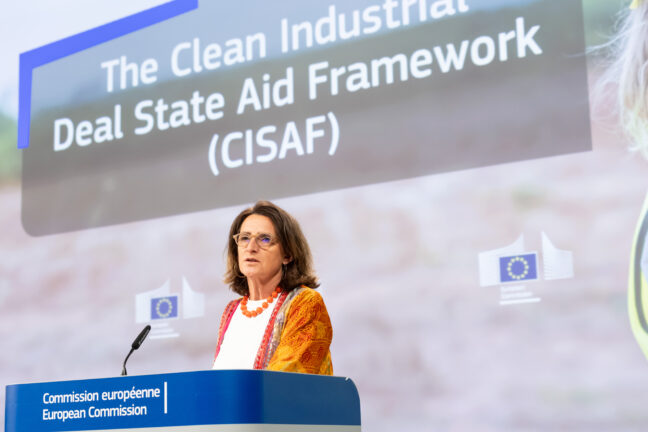The European Commission unveiled a new set of state aid rules on Wednesday, 25 June. The Clean Industrial Deal State Aid Framework (CISAF) defines the conditions under which national governments can provide financial support for investments aimed at promoting clean technology and energy efficiency.
The new framework, effective until December 31, 2030, is to replace the Temporary Crisis and Transition Framework (TCTF), which has been in place since 2022. CISAF is to facilitate the transition to clean energy and industrial decarbonisation across member states.
CISAF establishes a ‘fast-track’ process for the rollout of clean energy initiatives, encompassing support for both renewable energy and low-carbon fuels. Recognising the urgency of meeting decarbonisation goals, it simplifies procedures to accelerate the implementation of renewable energy schemes, while also promoting the adoption of low-carbon fuels like blue and green hydrogen.
How CISAF simplifies state aid rules
- the roll-out of renewable energy and low-carbon fuels
- temporary electricity price relief for energy-intensive users to ensure the transition to low-cost clean electricity
- decarbonisation of existing production facilities
- the development of clean tech manufacturing capacity in the EU
- the de-risking of investments in clean energy, decarbonisation, clean tech, energy infrastructure projects and projects supporting the circular economy.
The framework targets “hard-to-decarbonise” sectors, which often lack viable energy alternatives. It introduces flexible measures and capacity mechanisms that enable member states to integrate renewable energy sources like wind and solar into their electricity supply systems, ensuring reliability for consumers.
Subsidies for eletricity
The new rules permit governments to assist energy-intensive users by subsidising their electricity costs. Firms operating in sectors heavily reliant on power can now benefit from reduced electricity prices—lessening the competitive disadvantage they face against companies from regions with less strict climate policies. In exchange for this financial relief, these operators must commit to investing in decarbonisation efforts. The framework further allows for support across a wide range of technologies aimed at enhancing energy efficiency and reducing carbon emissions. This includes initiatives for electrification, carbon capture, and biomass, all deemed essential to achieving the EU’s ambitious climate targets.
“If Europe wants to lead in clean tech, we must act with courage and clarity,“ said Teresa Ribera, the Commission VP, who announced the inititative on Wednesday. “The new framework simplifies and speeds up support for decarbonisation, but it goes further: it recognises the state as a strategic investor in our future. It’s a tool to drive climate ambition, strengthen Europe’s resilience, and ensure our industry remains globally competitive,“ Ms Ribera explained the reasoning behind the change.
You might be interested
Moreover, CISAF provides mechanisms for supporting clean technology manufacturing within the EU. Member states can now back new manufacturing capacities for projects that align with the Net-Zero Industry Act, which is crucial for competitive clean technology production within Europe.
Berlin vindicated
The framework also outlines support for the processing of critical raw materials necessary for clean technologies. To bolster regional cohesion, states are permitted to offer greater support for projects located in less advantaged regions, thereby addressing disparities across the EU. The framework also encourages demand for clean technologies by allowing tax incentives for quicker deductions for relevant investments.
The introduction of CISAF marks a significant shift in EU economic policy and reflects the Commission’s acknowledgment of the need for substantial public investment to facilitate the transition to a decarbonised economy. EU State aid rules have historically prohibited member states from providing subsidies that could distort competition. However, as underscored by the developments surrounding CISAF, the Commission is increasingly moving towards accepting certain state aid measures as necessary for achieving broader environmental and economic objectives.
In a noteworthy instance that exemplifies this evolving policy stance, Germany’s plans to subsidise electricity costs for its energy-intensive industries, previously viewed as incompatible with EU regulations, may now gain traction under CISAF. The provisions included in the framework allow member states to implement “temporary electricity price relief” mechanisms, effectively validating Berlin’s plans.
Balancing act
The shift highlights an important realignment within EU state aid policy. The legislators recognize that such measures are critical to preventing economic downturns in member states heavily reliant on energy-intensive industries.
The CISAF framework also aims to address concerns raised by industry stakeholders. Recent communications from employer organisations representing ten EU countries, including Germany and Italy, expressed the view that the provisions may not extend far enough to support energy-intensive sectors adequately. Nevertheless, stakeholders have welcomed the mechanisms established under CISAF, particularly those geared toward facilitating investments in clean technologies and supporting local manufacturing.
Additionally, France is expected to benefit considerably from CISAF, especially with provisions that bolster support for nuclear energy. The updated framework references the Net-Zero Industry Act, which aligns with the French government’s priorities for nuclear development. French lawmakers have praised the broader inclusion of nuclear technologies, advocating for consistency between the framework’s provisions and the EU’s strategic energy goals.
If Europe wants to lead in clean tech, we must act with courage and clarity. – Teresa Ribera, Executive Vice-President for Clean, Just and Competitive Transition
Experts note that while CISAF offers necessary support for clean technology projects, it also reflects the Commission’s careful balancing act between facilitating industrial growth and adhering to the strictures of the single market. Safeguards are built into the framework to ensure that any State aid provided maintains competitive fairness within the EU. For instance, measures require that companies receiving electricity price relief reinvest a portion of that aid into decarbonisation efforts, preserving the principle of proportionality and necessity that underpins EU competition law.
Legal troubles ahead?
Looking ahead, the practical implementation of CISAF will be critical to its success. The Commission faces a challenging task in approving funding proposals and ensuring compliance with established regulations, especially as larger projects are presented for consideration.
The potential for legal challenges from companies that may claim unequal treatment under the framework could pose significant risks for the Commission’s decisions. Thus, the stakes are high as EU policymakers navigate the complexities of state aid amidst the pressing need for industrial reform and environmental sustainability in Europe.
In summary, the newly adopted Clean Industrial Deal State Aid Framework represents a transformative step towards aligning national support mechanisms with Europe’s decarbonisation objectives. By facilitating public investment in clean energy and technology, CISAF could significantly reshape the landscape of industrial policy in the EU, encouraging member states to take an active role in meeting long-term climate goals while ensuring economic viability.





